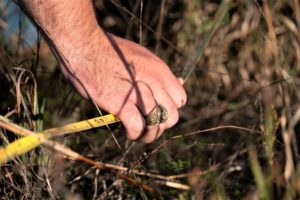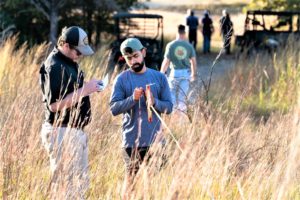Department of Rangeland, Wildlife and Fisheries Management looks ahead
Changes big and small lay foundation for department’s future
The Texas A&M Department of Rangeland, Wildlife and Fisheries Management has come a long way over last year.

Roel Lopez, Ph.D., head of the department in the College of Agriculture and Life Sciences, took the helm nearly a year ago. Since being appointed, he and other faculty have been planning the roadmap and laying foundational elements that will be critical for the department’s future.
An implementation strategy is now in the works, he said, to help navigate challenges and maximize opportunities for the department.
“It is an exciting time for the newly formed department of Rangeland, Wildlife and Fisheries Management,” Lopez said. “Faculty and staff have been working hard to grow the department, and enthusiasm and thoughtful actions have been key ingredients to develop something special. We expect this momentum to carry us into the future.”
Investing in student teaching and mentoring
Over the last year, the department has developed and added curricula and professional certificates in three discipline areas for students, said Gerard Kyle, Ph.D., associate department head of academics. The department’s course offerings will continue to provide degrees and certifications in rangeland, wildlife, and fisheries sciences and management professions.

The department is actively recruiting faculty who can bring problem-solving experience to students, Kyle said. Recently, the department hired several new faculty members representing disciplines ranging from natural resource economics, wildlife/fish diseases, soil and plant health and relationships to big game management, animal movements and data analytics that enhance other study areas resulting in a strong faculty team.
“Strong academics begin with a strong team of faculty, and we are working to assemble experts who can add value to the department’s degrees and certificates our students achieve,” he said. “The department has a strong reputation, but we are enhancing our ability to meet the professional needs within these fields and provide opportunities and careers for our students.”
Kyle said undergraduate students will access new, field-oriented experiential learning opportunities. For instance, a 10-day summer field course is held in collaboration with the Selah Bamberger Ranch to provide students with a range of hands-on learning opportunities centered around the practical application of techniques used in rangeland, wildlife and fisheries management.
During this year’s field course, students worked with faculty and a variety of professionals from private industry and nonprofit organizations such as the Texas A&M Natural Resources Institute, NRI, the U.S. Department of Agriculture–Natural Resources Conservation Service, and the Texas Parks and Wildlife Department.
Students have responded positively to the program, said Jim Cathey, Ph.D., professor and associate director of NRI.
“Students conveyed their appreciation for field experiences and hands-on learning, and the Selah Bamberg Ranch was the perfect laboratory,” Cathey said. “Their classroom education became real, as these juniors and seniors led the life of a field biologist. I am thankful to our colleagues outside of Texas A&M who made it a priority to teach, mentor and create professional pipelines for our students.”
Focused attention on stakeholder needs
The department has also been engaged with Texas A&M AgriLife Research and Extension Centers around the state to improve grazing lands, livestock and wildlife challenges by hiring Texas A&M AgriLife Research scientists and Texas A&M AgriLife Extension Service specialists to reinvigorate and develop critical labs and subject area centers.
Lopez appointed Bill Fox, Ph.D., rangeland ecologist and associate professor, to lead the Center for Natural Resources Information Technology, CNRIT, and Doug Tolleson, Ph.D., AgriLife Research range management specialist, to spearhead its Grazingland Animal Nutrition Lab, GAN, Lab, which is being relocated to Bryan-College Station.

CNRIT supports a holistic and interdisciplinary approach for research and outreach to support grazing operations, Fox said. It brings support systems to producers, which assist land management decisions through its two cohesive efforts, the GAN Lab and the Rangeland Decision-Support Laboratory, RDSL.
“We will engage with land and natural resource managers across the state to help guide management through science-based data while ensuring these decision-making resources are made easily available to the public,” he said.
The GAN Lab provides services to producers around the state to help monitor nutrition and physiology of domestic livestock, exotic hoof stock and native wildlife. This lab focuses on diagnostic diet analyses of animal manure to support strategic nutritional management recommendations.
These analyses, coupled with environmental data and computer modeling, can provide recommendations for sustainable grazing practices related to optimal animal weight or body condition, stocking rates, pasture rotation and supplemental feeding to meet producer goals, Fox said.
A suite of decision-support tools is also available to land managers through the RDSL, Tolleson said. These tools combine big data with various technologies, including remote sensing, computer simulation and GIS to inform land and environmental stewardship across the U.S. and around the world.
Tolleson said CNRIT and its labs use or create tools to address real challenges land managers face, including brush and weed management, plant growth dynamics, forage risk assessments, livestock nutrition and livestock market information.
The Center for Grazinglands and Ranch Management, CGRM, is being revitalized to deliver science-based practical solutions for Texas producers. Researchers will focus on threats like drought and emerging opportunities like carbon storage while following its mission to protect the ecological and economic resiliency of grazing lands and the ranching operations they support. Jeff Goodwin, Ph.D., NRI program director, will lead the center’s growth as incoming CGRM director.
Goodwin said there are 655 million acres of grazing lands in the U.S. Those acres support a wide variety of plants and animals and represent vital infrastructure for the livestock and ranch management industry.
“Our work and research will be applied to real-world needs, conveyed in meaningful ways, and inform policy-making that encourages wise use of these landscapes,” Goodwin said. “Linking the center across the Texas A&M University System and the students in the department are key ingredients to successful outcomes, where our work matters to stakeholders.”
Looking toward the future

Lopez said the department’s external advisory committee was instrumental in emphasizing the need for applied science focused on rangeland, wildlife and fisheries management and policy, with the intent to develop sound management practices and inform producer and policy maker decisions.
“Our administrators agreed, and now we are poised to achieve wonderful outcomes,” Lopez said.
Lopez said support for this vision means the department will remain at the forefront of problem-solving through applied science and connecting people with nature. With the global population nearing 8 billion, providing life necessities like food, water and shelter in sustainable ways will increasingly rely on innovative management practices.
The centers, faculty, staff and students will all play a vital role in addressing land, resource and ecological stewardship challenges, and providing sustainable solutions, he said.
Students will become next-generation experts, industry leaders and developers. Faculty will continue to build on established science and make new discoveries and breakthroughs. The centers will continue to work with stakeholders to streamline productivity and safeguard resources while improving ecological health.
“There are monumental challenges related to sustainability,” he said. “I am proud to lead this department and a group of people who are passionate about addressing the challenges with practical findings.”


